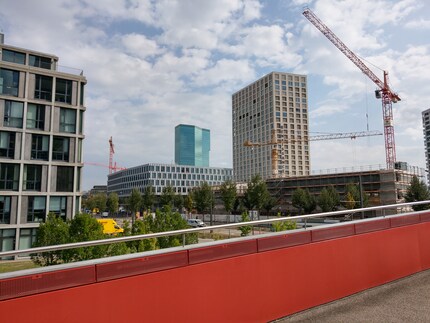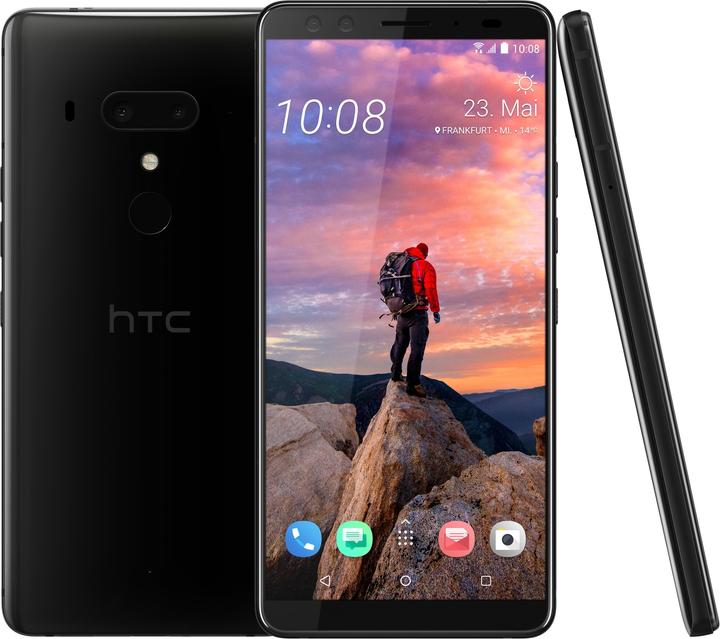

HTC U12+ tested: The flagship phone that nobody knows about
The HTC U12+ has corners and edges, and they react to touch. It doesn't need to fear comparison with the competition: the performance under the bonnet is just right. Thanks to the successful dual camera system, it plays in the top league.
HTC was once the smartphone pioneer that showed the others how to make smartphones. Then came the Apple competition from California. Then South Korea, and now China. Today, HTC is fighting fiercely for market share. And judging by the regularity with which analysts announce HTC's exit from the smartphone industry, I could set the clock.
The Taiwanese manufacturer apparently has no intention of exiting the smartphone industry.
The new HTC U12+ is proof of this. This much up front: there is enough power under the bonnet to play in the league of flagship mobiles. HTC's marketing emphasises the touch-sensitive edges, which I don't find spectacular at all - live on the edge is the slogan. But the new dual camera system including camera app makes up for everything.
Design: There's actually only one right choice
The large, white box with the rounded corners lying on my desk looks unassuming. But inside is a smartphone that can and wants to play with the big boys. I know this because I had the pleasure of holding the mobile phone in my hands a few months ago.
The HTC U12+ is available in three different colours: Titanium Black, Flame Red and Translucent Blue. However, only the latter is really exciting. The translucent blue is not completely transparent, but you can still see the battery, camera lens and LED flash from behind. That's striking enough if I pay attention to it, but not so striking that it looks over the top. I like that. Because the flashy designs from China, where some phones change colour depending on the viewing angle - they're not for me.

I play around with the semi-transparent brick. The smartphone feels very good in the hand; no comparison to the Nokia 8 that slipped around uncontrollably. It was smooth, but when I tested it, the camera lens broke. The HTC U12+ doesn't look as heavy as a brick either, despite weighing in at a hefty 188 grams. Its dimensions explain the weight:
- Height: 8.70 mm
- Width: 73.90 mm
- Length: 156.60 mm
This makes it most similar to the 189 gram Samsung Galaxy S9+. Huawei's P20 Pro or Honour's View 10 are slightly lighter, but also smaller.
HTC calls the glass design "Liquid Surface". Glass generally makes me sceptical because although it looks classy, it also has a magical attraction for fingerprints and grease stains. Just like glasses. Anyone who owns glasses knows what I'm talking about. We spectacle wearers suffer together, silently and bravely. But nobody has to suffer with the U12+. During my entire test period, I never once felt the urge to clean the mobile phone case. Sure, a few fingerprints can't be avoided, but it's not as bad as I feared. Black magic, HTC?

Another advantage of the glass design: beautifully soft edges. The Nokia 8 Sirocco, for example, gets it completely wrong. The edges are so sharp that I didn't dare touch the mobile without oven gloves.
The volume and standby buttons on the side of the phone take a little getting used to. These are not mechanical buttons, but touch-sensitive plates. Looks smart, but sometimes reacts a little sluggishly. Even though HTC promises that these plates are "unbreakable" in contrast to mechanical buttons - I still prefer the latter.

Good news for all notch haters: it doesn't have one. However, the 6-inch screen is smaller than that of the Huawei P20 Pro (6.1 inches) or Samsung Galaxy S9+ (6.2 inches), for example.
Beautiful screen, lots of power in the frame and useless edges
The first impression of the screen when switched on is good: although not AMOLED or OLED, the colours still look vibrant. The screen ratio is 18:9, which is standard for most smartphones these days.
The screen resolution is anything but standard. This is 2880 × 1440 pixels, which corresponds to a pixel density of 537 points per inch (ppi). I have never seen another smartphone with the same high pixel density. Not even the Huawei P20 Pro, which has a pixel density of 408 ppi.

A look at the specifications reveals: Mol, there's a lot of power in the woodwork here.
- Android 8 Oreo, upgradeable to Android P (date unknown)
- Qualcomm Snapdragon 845 processor with 6 GB of RAM
- Adreno 630 GPU
- 64 GB internal memory, expandable up to 2 TB
- Dual Sim: Yes, hybrid slot
- 3500 mAh battery
- IP68 protection class
The HTC U12+ is equipped with the Snapdragon 845, currently the most powerful system-on-a-chip (SoC) from Qualcomm. Although it can't quite keep up with Apple's A11 Bionic chipset, it still delivers plenty of computing power. Together with the 6 GB of RAM, the mobile didn't stutter or crash once during my entire test period. Swiping and swiping is very smooth and without delay, computing-intensive apps such as Spotify or WhatsApp ran smoothly.
The 3500 mAh battery was a little weak. The mobile barely managed a full day of use without charging once. I kept running home in the evening with between 15 and 20 per cent battery. No wonder: the mobile has a lot of pixels, which all require computing power and therefore more power. For that reason alone, I think the battery should have lasted longer. It's not a disaster, but other manufacturers do it better.
The edges are special: they react to touch. Predefined actions can be carried out by pressing both edges together at the same time or double-tapping an edge. For example, opening an app wheel that allows me to operate the smartphone with one hand.
HTC calls the function "Edge Sense 2" and wants to set itself apart from the competition. But it doesn't really do that. For example, the camera app lacks the option to zoom in and out by swiping the edges. In a music app, I would have liked the same gesture to control the volume. And a double or even triple tap should switch the display on and off - but it doesn't. What a pity.
If HTC were consistent, they would do away with the side buttons altogether and move their functions to the Edge Sense feature. That would be a design with a truly unique selling point. As it is, the feature is rather superfluous. Or at least not relevant enough to base an entire marketing campaign on it.
The camera is great. Period
The HTC U12+ shines with its dual camera system. And it really is. HTC has had two cameras before, but not in the predecessor model U11. Only one camera was installed there because HTC didn't think its dual camera system was mature enough.
Now it's back, and is making the competition, which also uses a dual camera system, sit up and take notice: DxOMark's camera testers have given the mobile the best rating that a dual camera system has ever received from them.

The hardware in a nutshell:
- Main camera sensor 1: 12.2 MP Ultra Pixel 4 with f/1.75 aperture and 25 mm focal length, optical image stabilisation and EIS
- Main camera sensor 2: 16 MP telephoto camera with f/2.6 aperture and 50 mm focal length and real-time bokeh mode
- Front camera: Dual cam, f/2.0 aperture with 28 mm focal length
- 4K videos with 60 frames per second
In more or less cloudy conditions, it takes good photos with natural, not oversaturated colours. Thanks to the powerful chip, the app has enough resources at its disposal for working and optimising.
Photo taken with the HTC U12+

The HDR mode is also a success. Where the difference between the darkest and brightest pixels is particularly large, cameras make an effort. Depending on the focus, parts of the image are either totally overexposed or underexposed.
Summer thunderstorm without HDR

In HDR mode, three photos with different exposures are taken within a fraction of a second and combined by the AI. As a result, bright areas of the image appear less bright and dark areas are brightened. The result is a balanced image.
Summer thunderstorm with HDR

The U12+ has a 2x optical zoom and even a tenx digital zoom. The artificial intelligence applies a sharpening filter to strongly zoomed images. It doesn't look really good. But I'm one of those photographers who would rather crop an image area than use the camera's digital zoom anyway.
I photographed a few trees outside the office. Trees have a lot of detail that will bring pretty much any smartphone AI to its knees, especially when zooming. Knowing that I will probably never need the tenfold zoom in my life, I want to know what the AI does.
The original image

Cropped vs. digital zoom


Top: On the left, a section that corresponds to a tenfold enlargement. On the right, a separate image where I used the tenfold zoom. The AI tries to draw the trees more sharply. It doesn't succeed badly. However, the colours, which look more natural in the section of the original image, fade.
The camera also has live bokeh. In this context, live means that you can see the result directly in the viewfinder when bokeh - i.e. artificial depth of field - is activated. The app calculates the effect with the blurred backgrounds live, not just after you have taken the photo.
Photo with automatic bokeh effect

By the way, I would switch off the beauty filter. Whoever that is in the picture on the right - it's not me.
Bokeh in selfie mode


In Pro mode, you can adjust the ISO values or white balance yourself. Particularly good for professionals: the images can be saved in RAW format, which makes subsequent editing on the computer easier.

Conclusion: Great flagship phone with a successful camera
The HTC U12+ is a flagship phone, and nobody knows it. HTC has lost much of its lustre in recent years. But with the HTC U12+ comes a phone that doesn't need to shy away from comparison with the big names from China or South Korea.
Edge Sense, the feature with the touch-sensitive edges, is a waste of time. But the design is impressive, especially the transparent version. The glass design feels good in the hand and leaves a classy impression. There is plenty of computing power under the bonnet, which makes the smartphone interesting for power users too. The battery is weak - no more, no less.
I was blown away by the camera and app. The HTC U12+ is the right choice for anyone who wants a smartphone to have a good camera that a phone is built around. <p
I'm an outdoorsy guy and enjoy sports that push me to the limit – now that’s what I call comfort zone! But I'm also about curling up in an armchair with books about ugly intrigue and sinister kingkillers. Being an avid cinema-goer, I’ve been known to rave about film scores for hours on end. I’ve always wanted to say: «I am Groot.»




